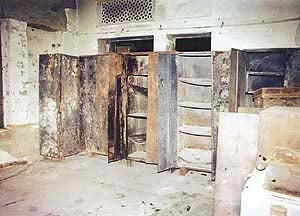
A few months ago, RP Singh wrote a very timely post on compassion and what it means to Sikhs. In Gurbani, the word Daya often translates to compassion, a trait which is long known in our history. One of the Panj Pyara or beloved five was Bhai Daya Singh and thus, Compassion along with Justice, Courage, Discipline and Leadership are important elements of the Khalsa.
As a reminder of this and as we get ready to begin a New Year – I wanted to share with you the Charter for Compassion – “a call to bring the world together.” It is stated that, The principle of compassion lies at the heart of all religious, ethical and spiritual traditions, calling us always to treat all others as we wish to be treated ourselves. Compassion impels us to work tirelessly to alleviate the suffering of our fellow creatures, to dethrone ourselves from the centre of our world and put another there, and to honour the inviolable sanctity of every single human being, treating everybody, without exception, with absolute justice, equity and respect. [link]
I would encourage you to watch the video below and sign the charter. It might be a passive form of activism, however, let it be a nudge to hold ourselves accountable in the coming years – to live compassionately and emulate Sikhi in one of it’s purest forms.
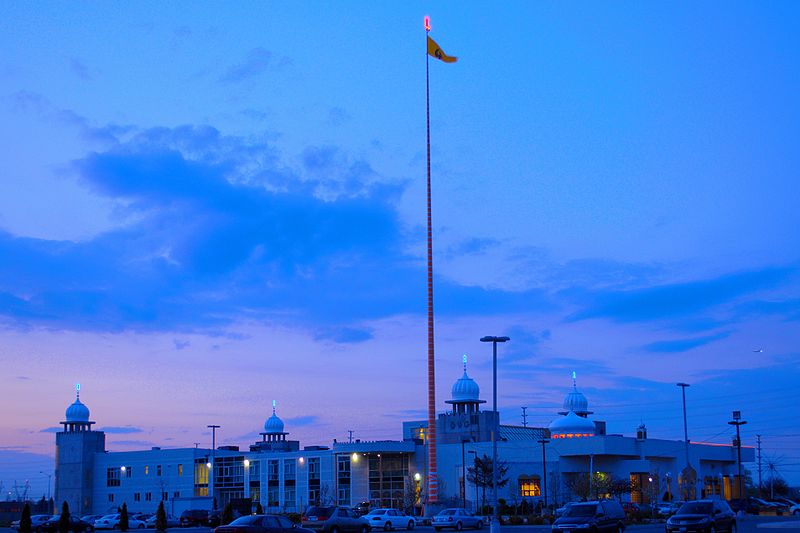 We often lament the state of our gurdwaras but we should just as often stop and think about how much we have accomplished.
We often lament the state of our gurdwaras but we should just as often stop and think about how much we have accomplished.
Tonight I had a chance to visit the famous Ontario Khalsa Darbar (aka Dixie) Gurdwara in Mississauga/Brampton, Ontario. On a frigid Friday night in December, the place was packed with sangat and programs.
In one hall, a Hindu Panjabi family was having a bhog for a deceased elder. On the other side agurmat sangeet teacher was having a kirtan for her daughter with beautiful kirtan being sung in raag by her many young students. In the adjoining halls, the United Sikhs organization was having their 2nd Annual Global Sikh Civil Rights Conference with tonight’s opening session focusing exclusively women’s issues. Upstairs, Harmeet Singh was holding his usual Friday session with hundreds of youth and their families. And to top this off Bhai (no longer Sant) Niranjan Singh Jawadi Kalan was performing kirtan to a packed hall in the main hall. Almost every program was in English or being translated into English on the screens.
So while we can (and should) continue to critically analyze the hardware (physical structures) and software (programs/initiatives) of our Sikh institutions, we need to simultaneously recognize when progress is being made.
Growing up I would have killed to have been a part of each of those individual programs happening at Dixie Gurdwara tonight (well maybe not the bhog) and today all of those functions were happening on the same day under the same roof.
On many days, it seems like we’re moving two steps back, but tonight I saw at least one step forward.
12/19/09
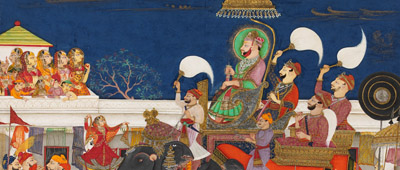 Guest Blogged by: Harinder Singh
Guest Blogged by: Harinder Singh
Last week I walked into the first exhibition to “comprehensively” explore the extraordinarily rich culture of the maharajas. “Maharaja – the splendor of India’s Royal Courts” is the feature exhibit at the Victoria & Alberta Museum in London and will be available through mid-January 2010. It was Susan Stronge, senior curator at V&A and friend of the Sikhs, who literally showed me the way to the V&A after a candid conversation over cafe latte about Sikhs, art, Orientalism, Barak Hussein Obama and Patwant Singh (late transnational Sikh ambassador). Her interest in my take on the Indian Maharaja’s depiction became the unusual catalyst to see the exhibition through two lenses: that of a Sikh and a South Asian.
Given that the number five in the Hindu numerology spans around business, marriage and romance, the five zones of exhibitions made sense. How the British have harbored such romantic notions of arbitrary boundaries of marriage and power in what it termed India! My journey through the exhibition started with the “Royal Spectacle” followed by the “Kingship in India.” It solidified with the “Shifting Power” that legitimized “The Raj’ which divided its subjects into “Princely India.” The only thing missing were the people, today’s South Asians.
 The issue of the loss of Sikh heritage sites and documents has long been lamented by many Sikhs. In fact, one of my fellow langa(w)riters blogged about the need to ‘preserve what history we have left.’ One group has been silently seeking to remedy this problem – the Nanakshahi Trust.
The issue of the loss of Sikh heritage sites and documents has long been lamented by many Sikhs. In fact, one of my fellow langa(w)riters blogged about the need to ‘preserve what history we have left.’ One group has been silently seeking to remedy this problem – the Nanakshahi Trust.
Quietly working on a massive project for over the past 6 years, the Nanakshahi Trust, along with the Sikh Research Institute, have inaugurated the Panjabi Digital Library:
For the first time ever a searchable collection of millions of rare pages on the Sikhs and the region of Panjab has been made available. Panjab Digital Library (PDL) will include texts of manuscripts, books, magazines, newspapers and photographs and will be available to anyone with Internet access at www.PanjabDigiLib.org. This launch was made possible in part by The Nanakshahi Trust and the Sikh Research Institute (SikhRI).
In today’s society, digitization is the key to immortality. While Sikhs have to be equally wary of those that claim Sikhs have no history as well as those that come up with their own ludicrous interpretations, a project such as the Panjab Digital Library allows Sikhs to access their own primary and secondary sources. Nanakshahi Trust has done a tremendous boon to Sikhs, researchers, and all that are interested in the preservation of history and man (and woman’s) historical past.
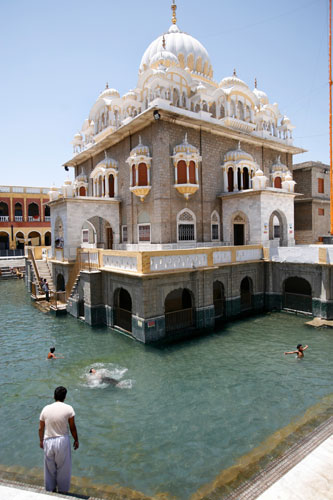 Gurdwara Panja Sahib, located just outside Pakistan’s North-West frontier province, has become the temporary home for about 3,000 Sikhs who have been displaced by the presence of the Taliban in the region. Gurdwara Panja Sahib is one of the most notable Sikh shrines in Pakistan and has been transformed into the ultimate role of a gurdwara. With help from community donations, the gurdwara has a clinic, a 24-hour kitchen and a temporary school for children. For the past two months, Sikh families have been living at the gurdwara, afraid to return back to their homes. Some of the region’s refugees have started to return back to their homes in military-protected convoys. However, many Sikhs feel they may never be able to move home,
Gurdwara Panja Sahib, located just outside Pakistan’s North-West frontier province, has become the temporary home for about 3,000 Sikhs who have been displaced by the presence of the Taliban in the region. Gurdwara Panja Sahib is one of the most notable Sikh shrines in Pakistan and has been transformed into the ultimate role of a gurdwara. With help from community donations, the gurdwara has a clinic, a 24-hour kitchen and a temporary school for children. For the past two months, Sikh families have been living at the gurdwara, afraid to return back to their homes. Some of the region’s refugees have started to return back to their homes in military-protected convoys. However, many Sikhs feel they may never be able to move home,
Two months ago, long-haired Taliban fighters stormed into Orakzai, a tribal agency near the Afghan border, brandishing AK-47 rifles and bringing a harsh demand: that the area’s 40 Sikh families should pay jazia, an ancient tax on non-Muslims living in an Islamic state. To encourage the payment of 12m rupees (£90,000), they kidnapped and tortured one of Singh’s neighbours. The Sikh community banded together to pay half the money, secured his release, then fled. “The Taliban are still demanding the money,” said Singh, a sprig of orange visible under his blue turban. “They recently rang me looking for the rest of the money. We are afraid they will find us, even here.” [link]
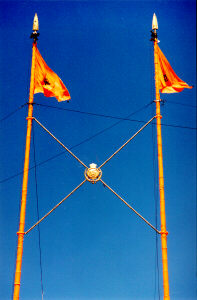 Play along with me here…imagine this Sunday you walk in to your local Gurdwara – remove your shoes, wash your hands, and as you make your way to the main darbar hall, you read the notices on the wall – “Education Committee holding Kirtan Classes Wednesday Night @ 6pm.” Next to that, another sign “Cultural Committee hosts Punjabi night next Saturday!” Further along, you see “Public Affairs Committee presents Interfaith Meeting on Friday.” Then right before you enter the darbar hall, you see…
Play along with me here…imagine this Sunday you walk in to your local Gurdwara – remove your shoes, wash your hands, and as you make your way to the main darbar hall, you read the notices on the wall – “Education Committee holding Kirtan Classes Wednesday Night @ 6pm.” Next to that, another sign “Cultural Committee hosts Punjabi night next Saturday!” Further along, you see “Public Affairs Committee presents Interfaith Meeting on Friday.” Then right before you enter the darbar hall, you see…
Human Rights Committee holding urgent action letter-writing workshop for two Indonesian prisoners of conscience, Sunday after Langar – and don’t forget the “Justice for Darfur” rally this Saturday morning, bus leaves at 8am Sharp!
Whoa! What kind of radical Gurdwara is this? What are the youth up to now? Is this one of those extremist Gurdwaras?
Or…is it the kind of Gurdwara Guru Sahib had intended?
Guru Nanak’s mission was based on the fundamental principle of human rights. We see this not only through his Baani, but throughout significant historical events – whether it was speaking out against the caste system and refusing to the wear the janeoo or his challenge of the tyrannical ruler Babar. Even in his ninth form, Guru Tegh Bahadur gave his life speaking out for a people whose practices he disagreed with, but supported their right to practice religion freely. He gave his life for the freedom of choice and the freedom of religion. There are several amazing stories of the Guru’s activism in the area of human rights and social justice…but strangely, this subject in the context of current events has now become taboo.
Continue Reading »
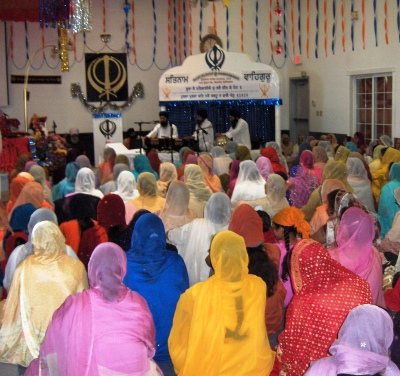 Phulkari’s post a few weeks back got me thinking about Gurdwaras – their origin and the role they play in Sikh society today. History tells us that Guru Nanak Patshah created Dharmshalas in Kartarpur where Sikhs would rise early and meet for Keertan, Veechar, reflection, and Guru-ka-Langar. It was a central element to the ideal society that Kartarpur would become.
Phulkari’s post a few weeks back got me thinking about Gurdwaras – their origin and the role they play in Sikh society today. History tells us that Guru Nanak Patshah created Dharmshalas in Kartarpur where Sikhs would rise early and meet for Keertan, Veechar, reflection, and Guru-ka-Langar. It was a central element to the ideal society that Kartarpur would become.
Over a century ago, Sikhs first arrived in North America – working at lumber mills, railroads, and as migrant laborers. They settled their families and chose to establish Gurdwaras (as early as 1908 in West Vancouver, BC and 1912 in Stockton, CA) to preserve both their spiritual and cultural roots in the land far from their history.
Now with hundreds of thousands of Sikhs in North America and the needs of our communities growing, the Gurdwara has expanded the services it offers far beyond its humble beginnings. Many Gurdwaras have Khalsa schools and libraries. Others plan for fitness centers, basketball courts, and healthcare clinics. One of the local Gurdwaras here hosts an annual Panjabi cultural show and mela, with weekly Giddha and Bhangra practices held at the Gurdwara facility itself. The North American Gurdwara has become not only a spiritual center, but also a community center, serving all the needs of the Sikh and Panjabi population.
On the one hand, I like having a Gurdwara as the center for our community’s activity. Although not all people have an initial interest in Sikhi, all these other events and programs at least keep people coming. And even a short “ritualistic” trip to the Gurdwara could develop in to something more. On the other hand, I can’t help but wonder…are we asking too much from our Gurdwaras?
With such different and competing interests, leaders fight for position so they can make their agenda the focus, and control Gurdwara resources accordingly. This drives much of the political drama and power struggles that surround our Gurdwaras today. As a result, many programs (such as Khalsa schools) end up mismanaged, poorly resourced, and inefficient.
Secondly, with all the programs our Gurdwaras offer, I question – are we taking away from the primary purpose of the Gurdwara…learning Gurmat (the Guru’s way)? How well do our Gurdwaras focus on Simran and Veechar? How well do our Gurdwaras connect the youth with the Guru’s message? What about services for non-Panjabi speakers or introducing non-Sikhs to our faith? What about programs emphasizing Sikh culture – like Gatka or Gurmat Sangeet? Are our Gurdwaras really institutions for learning? If the answer is less than perfect, shouldn’t we re-prioritize and change the focus of our Gurdwaras?
Many Gurdwaras serve small communities in rural areas where limited resources force the Gurdwara to serve multiple purposes. However, in larger communities, where resources are plenty – should we consider separating out our organizations? Maybe create separate Punjabi societies, Khalsa schools, clinics, and even Sikh community centers that focuses on outreach, youth counseling, and seva projects?
Perhaps under separate structures and management, these organizations will be able to thrive and meet their goals more efficiently with less resistance. And with our community’s growing needs, why not grow our presence with more diverse organizations?
Thoughts?
 As someone who considers herself honorary Peruvian (it’s a long story) – I was especially proud when I heard about Operation Walk – an organization established by Harpal Singh Khanuja and his wife Maria Khanuja. The non-profit organization is dedicated to providing free knee and hip replacements to underserved people around the world. The concept behind the organization was to perform complicated surgeries on people in developing countries, “where arthritis progresses to its end stages and reconstructing joints becomes technically challenging.” Often times, it is people who are most at need who cannot afford the surgery. A news article discusses Operation Walk’s recent trip to Lima, Peru where they performed 48 surgeries to replace knee and hip joints. Here on TLH we like to highlight examples of seva – this is another important example of what it means to do selfless service,
As someone who considers herself honorary Peruvian (it’s a long story) – I was especially proud when I heard about Operation Walk – an organization established by Harpal Singh Khanuja and his wife Maria Khanuja. The non-profit organization is dedicated to providing free knee and hip replacements to underserved people around the world. The concept behind the organization was to perform complicated surgeries on people in developing countries, “where arthritis progresses to its end stages and reconstructing joints becomes technically challenging.” Often times, it is people who are most at need who cannot afford the surgery. A news article discusses Operation Walk’s recent trip to Lima, Peru where they performed 48 surgeries to replace knee and hip joints. Here on TLH we like to highlight examples of seva – this is another important example of what it means to do selfless service,
“It was very rewarding to do this work for people and not expecting anything in return,” Harpal Singh said. “It’s really their gratitude that you cherish the most.”
The organization’s goal is to replicate the Peru mission to Panjab where the need is also great (some of which can be attributed to the chemical farming of the Green Revolution).
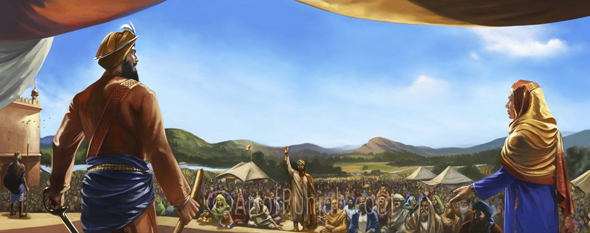
With Vaisakhi upon is, what is it you think of? Perhaps Anandpur Sahib, the city of bliss? Maybe the Panj Piaray, the five beloved ones? Or perhaps it is Guru Gobind Singh Ji’s message of fraternity and equality that resonates with you. Whatever it is that you think of, I wonder if it stirs you or moves you to see the world in a different light – in the light that our Guru hoped for us. On this day, in 1699, our Guru gave us the potential to be born again. Without caste, without discrimination, and without fear.
It is clear that issues of caste and discrimination still play a role in our communities today. However, I came across a promising article in the Guardian which discusses how a small café in India is challenging long-held caste taboos by hiring Dalit women to work within the café as waitresses. Although the Indian constitution banned untouchability sixty years ago, Dalits are still often forbidden, in villages and small towns, from doing anything other than low menial jobs. We all know it is not easy to challenge century-old beliefs, however this café is doing just that. As Sikhs, these issues should matter to us and we should stand up against injustice within any community.
An interesting paper, which I found on the Punjab Research Group site, titled “Dalits and the Emancipatory Sikh Religion” discusses the role Sikhi played in liberating Dalits.
It is beyond doubt that Sikhism emerged as an emancipator for the lowest of the low. Nanak, the first Guru, was clear when he says:
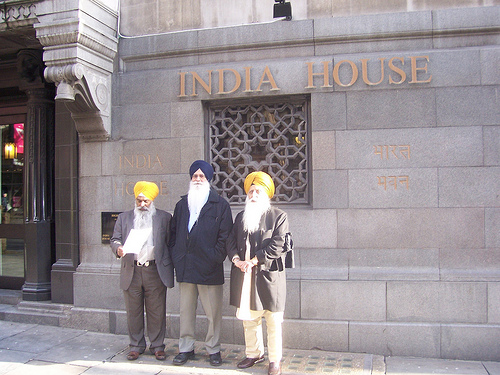 In the previous post, I had summarized a Stratfor report on the strong possibility of an Indian strike on Pakistan. Some Sikh groups in the UK, recently, released a formal appeal asking the Indian government to remove Indian nukes from the Punjab territory. Additional copies were given to the Pakistani embassy as well as the UN Security Council through the French Embassy. These Sikh groups have correctly surmised that East Punjab’s geography places it on the frontline of any conflict between India and Pakistan.
In the previous post, I had summarized a Stratfor report on the strong possibility of an Indian strike on Pakistan. Some Sikh groups in the UK, recently, released a formal appeal asking the Indian government to remove Indian nukes from the Punjab territory. Additional copies were given to the Pakistani embassy as well as the UN Security Council through the French Embassy. These Sikh groups have correctly surmised that East Punjab’s geography places it on the frontline of any conflict between India and Pakistan.
While news of the appeal has been reported in some Sikh media outlets, it is interesting that the mainstream Pakistani press has also picked up the report. The influential English-language Dawn writes:
The Sikhs maintain that they are not a party to the Indo-Pak dispute and, as non-combatants in the event of a war between the nuclear rivals, their population centre and homeland should not face what military experts have said is the likely outcome – a theatre of war in Punjab which becomes a nuclear conflict causing horrific casualties on a massive scale.[link]
In a significant development, the Government of Iraq has decided to rebuild the 15th century Sikh Guru Guru Nanak Dev’s shrine which was destroyed in the 2003 war in Baghdad. [link]
 Guru Nanak Dev Ji is said to have visited the place on his way back from Mecca where he stopped to speak with religious leaders including the caretaker of the mausoleums of Abdul Qadir gilani and Bahlol the Wise, who were greatly impressed by his views on God and religion. A monument, in the form of a platform, was raised where Guru Nanak had sat and provided these discourses. It is documented that Sikh soldiers who went to Iraq during the First World War, 1914-18, raised a Gurdwara here, but now only a room exists which is visited by Sikh and non-Sikh Punjabis who work in Iraq. In addition, it is noted that since the gurdwara is located within a graveyard, visitors are banned from staying overnight, cooking meals or holding Langar and Kirtan. I was not able to locate any information regarding who is currently in charge of the gurdwara or what the dynamics of the gurdwara are (without Langar or Kirtan). I do wonder if a Guru Granth Sahib is kept there and, in that case, who does the seva.
Guru Nanak Dev Ji is said to have visited the place on his way back from Mecca where he stopped to speak with religious leaders including the caretaker of the mausoleums of Abdul Qadir gilani and Bahlol the Wise, who were greatly impressed by his views on God and religion. A monument, in the form of a platform, was raised where Guru Nanak had sat and provided these discourses. It is documented that Sikh soldiers who went to Iraq during the First World War, 1914-18, raised a Gurdwara here, but now only a room exists which is visited by Sikh and non-Sikh Punjabis who work in Iraq. In addition, it is noted that since the gurdwara is located within a graveyard, visitors are banned from staying overnight, cooking meals or holding Langar and Kirtan. I was not able to locate any information regarding who is currently in charge of the gurdwara or what the dynamics of the gurdwara are (without Langar or Kirtan). I do wonder if a Guru Granth Sahib is kept there and, in that case, who does the seva.

Today many Sikhs in Southern California will celebrate Guru Gobind Singh Ji’s Gurpurb. When I think of Guru Gobind Singh Ji, the first thing that comes to mind is the creation of the Khalsa as an army of the pure.
This past summer I was sitting in a group-discussion, with fellow 2nd generation Sikhs (amritdhari and non-amritdhari) in the West, where we were asked to share the first thoughts that came to mind when we thought of the term “Khalsa”. Here are some:
masculine, extremists, ego, amrit, air india bombings, khalistan, rules, khandha/militaristic, collective brotherhood, fiercely independent, love, panj pyare, historical of the past & raj karega khalsa
For myself, I thought it was interesting to see how the media (i.e. newspaper articles, calendars, and television) along with the politicalization of religion and translation of Sikhi between generations is influencing our perceptions of the Khalsa.
What are your thoughts? What do you think they reflect about the state of the Khalsa?
 Well I was hoping someone far more knowledgeable from our esteemed blog roster would write about this, but I figured since I feel it is extremely important and raises some critical issues, you’ll have to settle for me.
Well I was hoping someone far more knowledgeable from our esteemed blog roster would write about this, but I figured since I feel it is extremely important and raises some critical issues, you’ll have to settle for me.
Yesterday when I was watching CNN, Jasvinder Sanghera came on to talk about the recent release of Humayra Abedin.
For those that may not be aware, Jasvinder Sanghera is the author of a biography called Shame and the founder of Karma Nirvana, “[an organization] with a view to create support project for women who experienced language & cultural barriers.” I have read Sanghera’s memoirs and although her particular story of her parents’ attempt to force her into a marriage and the consequences she experienced is more extreme than most cases, still it echoes the larger problems of “forced marriage” in our community and differences may only vary in degree.
A Sardar friend of mine once recounted his experiences flying soon after 9/11. He was flying within California to a small Central California city. Upon arriving he had to wait for his plane-side check-in luggage and the air-hostess joked that he was lucky to have flown at all. When he asked why, she told him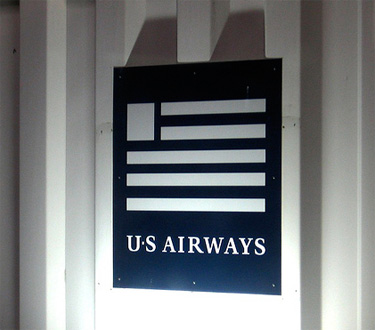 that 2 customers had felt ‘uneasy’ with him on the plane and had they had a third complaint, he would not have been allowed to fly. He asked if he was flying with his three friends, could they report that they felt ‘uneasy’ if they saw a man with a cowboy hat. The air-hostess replied that – that would be a different situation.
that 2 customers had felt ‘uneasy’ with him on the plane and had they had a third complaint, he would not have been allowed to fly. He asked if he was flying with his three friends, could they report that they felt ‘uneasy’ if they saw a man with a cowboy hat. The air-hostess replied that – that would be a different situation.
It seems for 3 “eminent Sikh classical musicians” there situation was not much different than others that flew post 9/11. In a news report that is widely circulating in the Indian press, three Sikh musicians were on board to fly from Sacramento to Salt Lake City on US Airways were asked to deboard the plane after they had cleared proper TSA security clearances, at the whim of the pilot:
The incident occurred after Gulbag, Davinder, and Iqbal Singh cleared Transportation Security Administration (TSA) security and boarded US Airways flight no. 0493 on November 15th in Sacramento, California, on their way to Salt Lake City, Utah. The three were sitting together in the rear of the plane, in their assigned seats. After having been on the plane for approximately ten minutes, they were approached by one of the ticket-reception desk workers and asked to exit the plane. While none of the three adequately comprehend or speak English, the group complied and exited the aircraft. When it became apparent that the group was unable to converse with US Airways representatives, a Panjabi interpreter was called to assist.

“The first step in liquidating a people is to erase its memory. Destroy its books, its culture, its history. Then have somebody write new books, manufacture a new culture, invent a new history. Before long that nation will begin to forget what it is and what it was… The struggle of man against power is the struggle of memory against forgetting.” – Milan Kundera, The Book of Laughter and Forgetting
Sikhs have never been big on preservation. Partly because we’ve spent most of our 500+ year history fighting for very existence, but in recent years its been a greater combination of complacency, incompetence and real external efforts to mess with our past. All of this has contributed to a situation where, it has been said by some experts, that 80% of Sikh history (architecture, artifacts, texts, etc) has been destroyed in the last 100 years.
According to a 1968 publication of SGPC called ‘sada hath likhat sahit,’ the Sikh Reference Library contained 383 volumes that covered 980 different topics. Amongst this repository were several Hukamn?m?s, 2500 hand-written sarups of Guru Granth Sahib, and other rare historical documents. One historical document was written by Bhai Gurdus and bore a hand-written Mul Mantr page by the Ninth Nanak.
The library also consisted of a manuscript dated 1739 Bikram? that was prepared by Guru Gobind Singh Sahib five years after the martyrdom of Guru Teghbahadur Sahib – in this document, the Tenth Nanak added the writings of the Ninth Nanak at Damdama Sahib to the Guru Granth S?hib.
Unfortunately, the Indian Army set the building on fire on June 7, 1984, destroying a majority of these rare documents. In recent years, the Indian Defense Minister has also admitted to the burning or removal of material from the Sikh Reference Library.
 This post is sort of dedicated to P.Singh. Let me first begin by saying that I agreed with ALL (and I use that word only after re-reading all of his comments) of the points that he made in a prior post (not all of his comments in other posts, but I digress….).
This post is sort of dedicated to P.Singh. Let me first begin by saying that I agreed with ALL (and I use that word only after re-reading all of his comments) of the points that he made in a prior post (not all of his comments in other posts, but I digress….).
However, I did want to revisit the topic of Dr. Pashaura Singh in light of some more news, posit a contrarian viewpoint based on an academic article, and then revisit the question of endowed Sikh chairs.
Update on Dr. Pashaura Singh
On Friday of last week, Sikhs throughout California organized buses down to the UC Riverside campus to protest Dr. Pashaura Singh’s hire as the chair of the endowed Jasbir Singh Saini Chair in Sikh and Punjabi Language Studies. While newspaper articles stated that over 300 people were in attendance, my own eye-witness sources claim that it was in excess of 500.
Heads-up friends, the season of the “Spinning Wheel Festival” is about to begin across North America this autumn. Celebrating Sikh films and art, the first stop will be in New York City on Saturday, October 04, 2008 at the Asia Society & Museum (p.s. that’s next Saturday). Buy your tickets NOW! The wonderful Rabbi Shergill will be performing at the opening gala (yes I am really biased here … I heart Rabbi Shergill) and DJ Rekha will be literally “spinning” at the after party.
Films a the NYC festival will range from documentaries on Pahelwani (i.e. Panjabi wrestling) and Kaba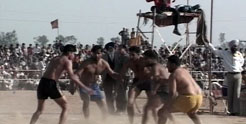 ddi-playing Canadian police officers to issues affecting the Sikh community from 1984 and post-9/11 hate crimes. There will also be short and feature films. For example, one on a young boy’
ddi-playing Canadian police officers to issues affecting the Sikh community from 1984 and post-9/11 hate crimes. There will also be short and feature films. For example, one on a young boy’ s struggle to keep his hair while his family fears the obstacles he will encounter and another on “… a young Sikh doctor struggling with the inequities of the American Health System and ultimately his own identity”. The Holy Duels of Hola Mohalla is a film looking at the Khalsa Panth.
s struggle to keep his hair while his family fears the obstacles he will encounter and another on “… a young Sikh doctor struggling with the inequities of the American Health System and ultimately his own identity”. The Holy Duels of Hola Mohalla is a film looking at the Khalsa Panth.
The films seem interesting both in content and presentation. The stories are grounded in the realities many of us encounter everyday. You can get a full listing of the films and their synopses here.
In the past, I have attended the “Spinning Wheel Festival” at one of its many North American stops and found it a great space for artists and art-enthusiasts to be exposed to Sikh creativity. I remember there being a panel discussion with the directors and the audience. We don’t have too many of these creative opportunities in our community even though we spend plenty of time and space advertising foreign medical schools in Poland, China, and the Caribbean.
I have found that some films are really hit or miss at these festivals, but it’s expected sense the focus is on cultivating and inspiring creativity; while, building a permanent Sikh film festival for years to come. Cash prizes are awarded to the “bests” in various categories. I have been told that the listing and quality of films varies across the different North American stops.
At the end of the day why not go, especially if it’s close by. I personally think it’s worth a visit as an act of supporting Sikh arts and learning about the various issues affecting our community. Sometimes we get too caught up in our own worlds and don’t realize these issues are taking place or we are in amidst of them and they become normal parts of our lives leaving very little room for reflection or exposure to others’ perceptions. Thus, it’s an 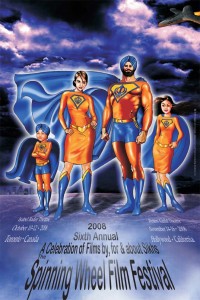 opportunity to get a fresh/new look at various issues.
opportunity to get a fresh/new look at various issues.
Lastly, the arts, from painting and photography to films and music, are our community’s soul! They help us speak in ways we can’t always articulate. So go save your soul and attend a Sikh artistic event! 
Okay, enough of the attempt at convincing … the other North American stops will be:
- Toronto, Canada from October 10-12, 2008 at the Isabel Bader Theatre.
- Hollywood, California from November 14-16, 2008 at the Writers Guild Theatre.
Are ya’ll thinking of going? What have your experiences been at the various Spinning Wheel Festivals? Does anyone know of other North American stops?
p.p.s. The Toronto and Hollywood poster is really interesting isn’t it … a conversation in of itself!
For many of us Sikhs of Panjabi-background, those Sikhs that chose to embrace Sikhi (often termed as ‘goray Sikhs’, but by no means are all of them of such ‘gora’ background) are sometimes seen as an enigma. Too often stereotypes and easy labels such as ‘hippie’ or ‘weird’, knee-jerk opinions on ‘yoga’, or even a certain ‘guilt’ in terms of our own relationship with our Guru tend to be expressed in hushed tones. 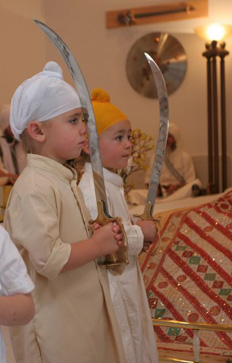 However, such labels only dehumanize those that we should be most embracing as brothers and sisters of a shared Guru.
However, such labels only dehumanize those that we should be most embracing as brothers and sisters of a shared Guru.
A recent article in a local Surrey newspaper recently has me re-thinking how as a Sikh community we can continue to strengthen our Qaum. Reading about Hari Nam Singh Khalsa’s own evolution was not only inspiring, but also a point for reflection.
The Oakville, Ontario resident is the host of the only English-language program on Canadian television that provides knowledge about Sikhi. His “Insight into Sikhism” airs on Saturday mornings throughout Canada (you can click here for Canadian times and channels). On the show’s website, the program’s purpose is described as:
Each week, host HariNam Singh Khalsa explains aspects of the Sikh religion and its relevance to modern day issues. Insight into Sikhism introduces the core principles of Sikhism in a simple and basic format in English for everyone to understand. HariNam Singh’s mission is to spread the universal teachings of Sikhism to people of all faiths.[link]
Although I have never seen the show (if you have, please do comment and let us know your thoughts about it), it seems like a remarkable and much-needed project.
Newspapers in Panjab have been buzzing about the recent proposal by the Sikhs in Haryana to form their own Gurdwara political body. However, the Chief Minister of Punjab, Parkash Singh Badal, and head of the Akali Dal has been on a warpath trying to prevent such a move. Badal even went so far as to give a sort of veiled threat of the outcome by such a move:
“We are a peace-loving community and hope that attempts to open a fresh festering wound in the country in Punjab would be dropped. The whole of country is already up in flames and it can easily do without another trouble spot in Punjab along the lines of Jammu and Kashmir.” [link]
The problem with forming an opinion or even coming to terms with the situation is the layers of political intentions and motives. In a move to somewhat demystify and explain the situation, I write this post.
The Sikh Research Institute (SikhRI) reported today that Arpinder Kaur, 28, of San Antonio, Texas has become the first turbaned pilot hired by a commercial airline in the United States. As a Sikhni, she has helped pave the way for both Sikh men and women who wear a dastaar/turban to fulfill their passion for flying. No longer does flying just have to be an extra-curricular activity for these Sikhs, but it can also be an every-day job!
States. As a Sikhni, she has helped pave the way for both Sikh men and women who wear a dastaar/turban to fulfill their passion for flying. No longer does flying just have to be an extra-curricular activity for these Sikhs, but it can also be an every-day job!
In March 2008, after resolving the issue of wearing her dastaar on-the-job, with the help of the Sikh Coalition, Arpinder Kaur was officially hired by American Airlines Corporation (AMR) as a First Officer. She filed her grievance for accommodation of her religious article of faith based on American Airlines’ allowance of “regulation approved hats”. An agreement was reached that is consistent with state and federal anti-discrimination law. In June 2008 she finished her pilot training program and is now flying Embraer Jets for American Eagle, a regional airline that is part of AMR based out of the Dallas-Fort Worth International Airport.
When Arpinder Kaur was asked why she chose to do this, she said:
“Two of the reasons I did this were: first, my love of flying and, second, to set a precedent for the community so they know you can be in your Sikh appearance and do anything out there; so that my younger brothers and sisters [the rising generation] will pursue their passions while practicing their Sikh faith.”
Her passion for flying first started when at the age of 15 she got to sit in the cockpit of an airplane when moving from Panjab. Despite having a degree in Information Systems and her mother’s belief that it was too dangerous for a girl to be a pilot, Kaur has chosen to follow her passion; while using it as a means for supporting her family. Kaur said it was the love and support of her husband, Pritpal Singh that pushed her forward on the path toward becoming a pilot. Kulbir Singh Sandhu, captain with AMR mentored her throughout her aviation career. From 2003 to 2005 Kaur was trained by Jesse Sherwood in Kansas. With the help of these individuals and others along with her own perseverance and determination, Kaur and American Airlines have shown that accommodation and not assimilation is the way to harness the strength of diversity in America.
Harinder Singh, executive director of the Sikh Research Institute (SikhRI) in San Antonio, Texas said, “This is a great day for the Sikhs in America. Religious accommodation, not assimilation, is what the founders of this great nation envisioned and we are thrilled American Airlines celebrates the rich religious and cultural diversity of all American populations.”
Here is a short film on Arpinder Kaur and “piloting”:

